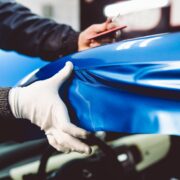In an age where climate change and sustainability are at the forefront of global concerns, industries across the board are adopting eco-friendly practices. The automotive repair industry is no exception, and Paintless Dent Repair (PDR) has emerged as an innovative, environmentally responsible solution for addressing vehicle dents, dings, and hail damage.
Why Traditional Repairs Have an Environmental Impact
Conventional auto body repairs rely on processes that are not only resource-intensive but also harmful to the environment. Here’s how traditional methods contribute to pollution and waste:
- Chemical Use: Traditional dent repair often involves body fillers, primers, and paints, many of which contain volatile organic compounds (VOCs). These chemicals release harmful emissions into the air, contributing to poor air quality and environmental degradation.
- Excess Waste: The process of sanding generates dust and debris, while leftover materials—such as empty paint cans, filler tubes, and used sanding pads—add to landfill waste.
- Energy-Intensive Processes: Conventional repairs require equipment like spray booths and heat dryers, which consume significant amounts of energy and increase the carbon footprint of the repair process.
- Material Disposal: Panels or parts that are replaced rather than repaired are often discarded, leading to increased waste and a greater demand for raw materials to manufacture new components.
How Paintless Dent Repair (PDR) Protects the Environment

PDR offers a cleaner, more sustainable alternative to traditional dent repair methods. Here’s why it’s an eco-friendly option:
- Elimination of Chemicals and Paint:
PDR does not rely on paints, solvents, or fillers, eliminating the need for harmful chemicals that release VOCs. By avoiding these materials, PDR minimizes environmental pollution and health risks for technicians. - Minimal Waste Generation:
Since PDR works by restoring the original body panels rather than replacing them, it generates virtually no waste. This means no discarded panels, sanding dust, or leftover repair materials that would otherwise end up in landfills. - Lower Energy Consumption:
Unlike traditional repairs that require energy-hungry equipment like heat lamps, spray booths, and compressors, PDR involves manual tools and minimal power usage. This significantly reduces the overall energy footprint of the repair process. - Sustainability Through Longevity:
By preserving and extending the life of the original panels, PDR reduces the need for manufacturing new parts. This conserves natural resources like steel and aluminum while decreasing the environmental impact of raw material extraction and production.
Economic and Practical Benefits for Vehicle Owners
While the environmental benefits of PDR are impressive, the method also offers tangible advantages for vehicle owners. Here’s how PDR creates a win-win situation:
- Cost Savings: The streamlined process eliminates the need for expensive materials and reduces labor time, resulting in lower repair costs.
- Preserved Value: By maintaining the vehicle’s factory finish, PDR helps protect its resale value. Buyers are often wary of repainted vehicles, as they may suspect prior damage.
- Quicker Turnaround Time: PDR repairs are faster than traditional methods, meaning you spend less time waiting and more time on the road.
- Enhanced Convenience: With minimal downtime and fewer resources required, PDR offers hassle-free repair experience for car owners.
Why PDR Is the Future of Eco-Friendly Auto Repairs
The shift toward sustainable practices in the automotive industry is gaining momentum, and PDR stands out as a leading example. By choosing PDR over conventional repairs, vehicle owners actively contribute to reducing their environmental footprint. Moreover, as the demand for eco-friendly services grows, PDR is likely to become the gold standard for minor dent and hail damage repairs.
Environmental Awareness Meets Automotive Innovation
Paintless Dent Repair exemplifies the harmony between environmental consciousness and technological innovation. By avoiding the need for chemicals, minimizing waste, and conserving energy, PDR not only delivers high-quality results but also aligns with the values of environmentally conscious consumers.
Conclusion: A Greener Choice for Car Owners
For vehicle owners looking to minimize their environmental impact without sacrificing quality, Paintless Dent Repair offers the perfect solution. By opting for PDR, you’re not just restoring your car to its original condition—you’re also playing a part in creating a cleaner, more sustainable future. Next time your vehicle suffers dents or dings, consider PDR for a repair solution that benefits both you and the planet.













Comments